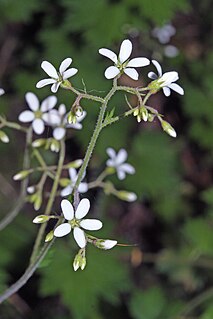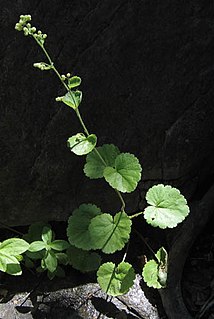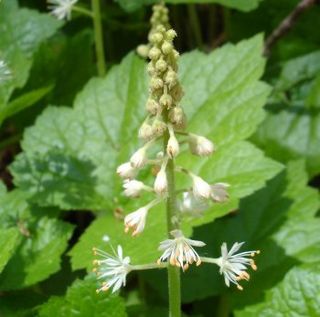
The western mouse is a species of rodent in the family Muridae. Its Australian Aborigine name is Walyadji. It is found only in Australia.

Boykinia is a small genus of plants related to the saxifrages. It contains at least nine species, known as brookfoams. Brookfoams are glandular rhizomatous creeping perennials with highly lobed or toothed leaves and inflorescences of petite flowers. They are native to North America and Asia.

Euonymus occidentalis is a species of spindle tree known by the common names western burning bush and western wahoo. It is native to western North America from British Columbia to California, where it is the only member of its genus growing wild. This is a shrub or small tree reaching maximum heights of anywhere from two to six meters. The thin, green, oval-shaped leaves are up to one and a half centimeters long and sometimes rolled under along the edges. The inflorescence holds up to five small flowers at the end of a long peduncle. Each flower has five rounded pink to brown and white mottled petals around a central nectar disc with 5 nubs. The fruit is a rounded capsule with three bulging lobes. It opens to reveal one seed in each of the three lobes. The seed in concealed in a red aril.

Geranium oreganum is a species of geranium known by the common name Oregon cranesbill, or Oregon geranium. It is native to western North America from California to Alberta, where it grows in mountain forests and meadows. This is a perennial herb growing generally erect to heights of 40 to 80 centimeters. The slender stems have a foliage of large palmate leaves up to 15 centimeters wide and divided into several segments, each of which is subdivided into rounded or pointed lobes. The flower has pointed sepals beneath rounded lavender to purple petals. The fruit has a small body with a pointed style column up to five centimeters long.

Hierochloe occidentalis is a species of grass known by the common name California sweetgrass. It is a close relative of the more widely known sweet grass. It is native to the west coast of the United States from Washington to California, where it grows in the coniferous forests of the coastal mountain ranges. This is a rhizomatous perennial grass with leaves up to 30 centimeters long and 1.5 wide. The stem reaches a meter in height with an inflorescence of 7 to 10 centimeters. The spikelets grow on short, wavy stalks and each has three florets with long, protruding stamens during flowering.

Androsace occidentalis is a species of flowering plant in the primrose family known by the common name western rockjasmine.

Boykinia major is a species of flowering plant in the saxifrage family known by the common name large boykinia. It is native to the western United States from California to Montana, where it grows in shady forest understory and wet mountain meadows. It is a rhizomatous perennial herb producing large leaves with blades up to 50 centimeters long, borne on petioles up to 35 centimeters in length. Each leaf has several lobes which are often sharply toothed along the edges. The inflorescence reaches up to a meter tall on a thin stem. It bears a dense, flat-topped array of many small white flowers with yellowish centers, each with five pointed sepals and five larger rounded or oval petals.

Boykinia rotundifolia is an uncommon species of flowering plant in the saxifrage family known by the common name roundleafed brookfoam. It is endemic to Southern California, where it grows in shady forested areas near streams in the mountains.

Calystegia occidentalis is a species of morning glory known by the common name chaparral false bindweed.

Calystegia peirsonii is a species of morning glory known by the common name Peirson's false bindweed.
Cardamine occidentalis is a species of cardamine known by the common name big western bittercress. It is native to western North America from Alaska to northwestern California, where it grows in moist mountain habitats.

Crepis occidentalis is a North American species of flowering plant in the daisy family known by the common names western hawksbeard, or largeflower hawksbeard. It is native to western Canada and the western United States.

Lilaeopsis occidentalis is a species of flowering plant in the carrot family known by the common name western grasswort. It is native to the coastline western North America from far southern Alaska to California, where it grows in brackish and salt marshes. This is a perennial herb producing a tuft of thready but stiff and erect grasslike leaves up to about 30 centimeters long from a rhizome network. The minute flowers are located in an umbel on a short stalk. They yield tiny round fruits only 1 or 2 millimeters wide.

Nitrophila occidentalis is a species of flowering plant in the amaranth family known by the common name boraxweed. It is native to the western United States and northern Mexico, where it can be found in habitat with moist alkaline soils, such as salt pans. It is a rhizomatous perennial herb producing decumbent or erect stems up to about 30 centimeters tall. The stems have paired branches lined with oppositely arranged, fleshy, linear or oblong green leaves up to 1.6 centimeters in length. Flowers occur in the leaf axils, alone or in clusters of up to 3, accompanied by small bracts. The flower lacks petals but has five pointed sepals 1 or 2 millimeters long which are white or pink in color, fading white with age.
Oxypolis occidentalis is a species of flowering plant in the carrot family known by the common name western cowbane. It is native to sections of western North America, where it grows in forests and other habitat. It is a perennial herb growing from tubers and producing erect, branching stems up to 1.5 meters tall. The leaf has a blade up to 30 centimeters long which is divided into many toothed, lobed, or deeply cut leaflets. The blade is borne on a long petiole, with upper leaves having larger petioles than basal. The inflorescence is a dense compound umbel of many small white flowers.

Rudbeckia occidentalis is a species of flowering plant in the aster family known by the common name western coneflower. It is native to the northwestern United States from Washington to northern California and east to Wyoming and Montana, where it grows in moist habitat types, such as meadows. It is an erect perennial herb growing from a thick rhizome, its mostly unbranched stem approaching two meters in maximum height. The large leaves are generally oval but pointed, and lightly to deeply toothed along the edges, growing to 30 centimeters long. The inflorescence is one or more flower heads with purplish bases up to 6 centimeters wide. There are no ray florets, just an array of reflexed phyllaries around the purple-brown center packed with disc florets. This center, containing the receptacles, lengthens to several centimeters in length as the fruits develop. The fruits are achenes each a few millimeters long, some tipped with pappi of tiny scales.

Silene occidentalis is a species of flowering plant in the pink family known by the common names western catchfly and western campion.

Trautvetteria is a genus of flowering plants in the buttercup family. Today it is often considered a monotypic genus, containing only one species, Trautvetteria caroliniensis, which is known by the common names Carolina bugbane, false bugbane, and tassel-rue. A second species, T. japonica, is now generally considered a variety of this species. The genus is named for the botanist Ernst Rudolf von Trautvetter.

Valeriana occidentalis is a species of flowering plant in the honeysuckle family known by the common name western valerian. It is native to the western United States, particularly the northwestern quadrant, but it occurs as far south as Arizona and as far east as Colorado and South Dakota. It occurs in moist, forested mountain habitat. It is an erect herb growing 30 to 75 centimeters tall with whorls or opposite pairs of leaves at intervals along stem. The leaves are generally divided into lobes or are compound, with each leaf made up of a few oval-shaped leaflets. The inflorescence is a dense cyme of many funnel-shaped white flowers each 3 or 4 millimeters long with three long, protruding stamens. The fruit is a ribbed achene about half a centimeter long which may be tipped with the featherlike remains of the flower sepals.

Boykinia aconitifolia, also known as Brook saxifrage and Allegheny brookfoam, is a species of vascular plant in the genus Boykinia. It is native to the southeastern region of the United States, ranging from West Virginia to Alabama and Georgia. It grows in wet woodlands, on the edges of ponds and lakes, or in other moist areas, flowering in the summer. It has both basal and cauline leaves, with petioles three to eighteen centimeters long. Leaves are generally reniform, but can be orbiculate to cordate with three to seven lobes. The seeds are black with tubercles.






















